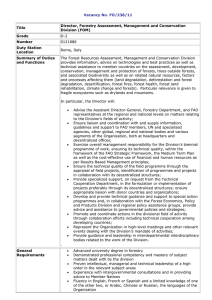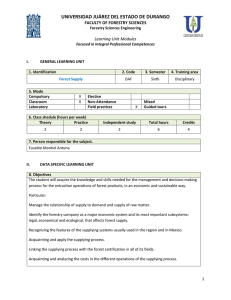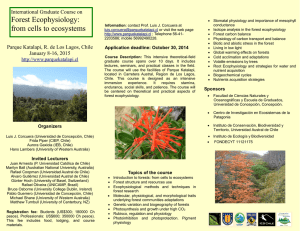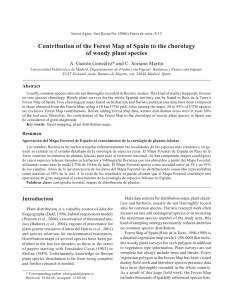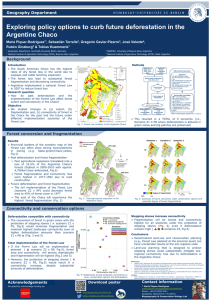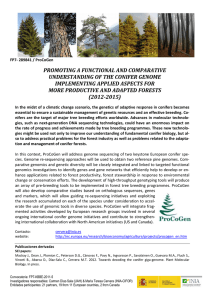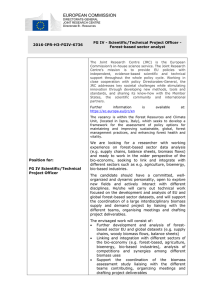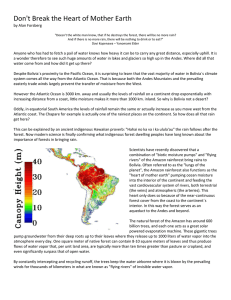Forest inventory and analysis. A national inventory and monitoring
Anuncio
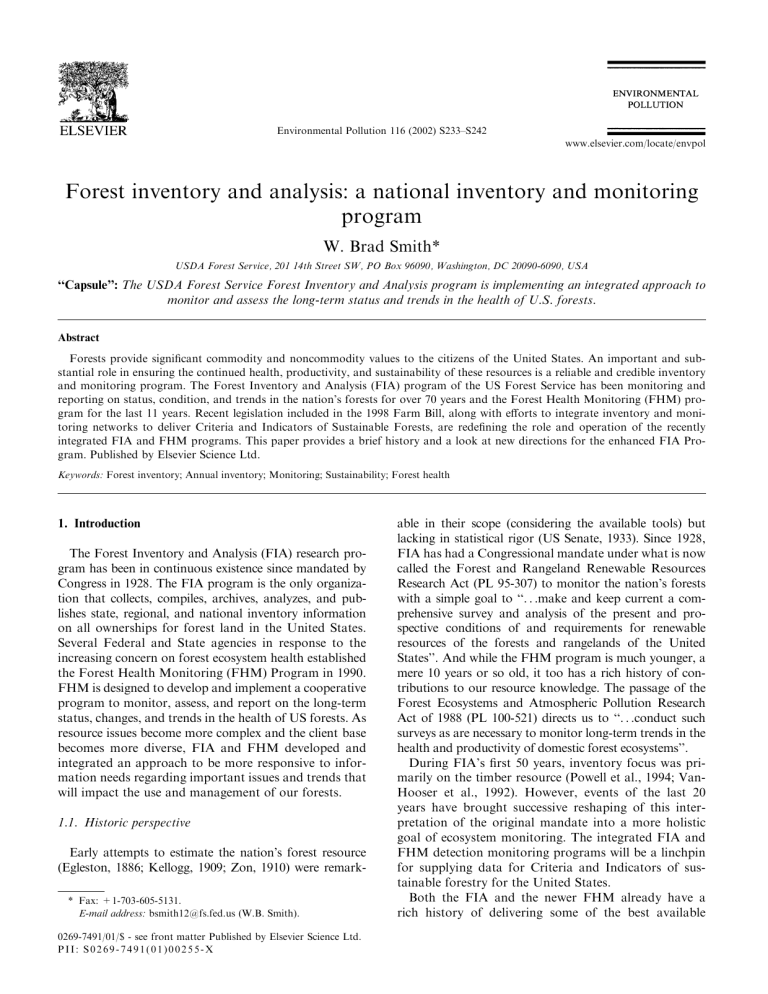
Environmental Pollution 116 (2002) S233–S242 www.elsevier.com/locate/envpol Forest inventory and analysis: a national inventory and monitoring program W. Brad Smith* USDA Forest Service, 201 14th Street SW, PO Box 96090, Washington, DC 20090-6090, USA ‘‘Capsule’’: The USDA Forest Service Forest Inventory and Analysis program is implementing an integrated approach to monitor and assess the long-term status and trends in the health of U.S. forests. Abstract Forests provide significant commodity and noncommodity values to the citizens of the United States. An important and substantial role in ensuring the continued health, productivity, and sustainability of these resources is a reliable and credible inventory and monitoring program. The Forest Inventory and Analysis (FIA) program of the US Forest Service has been monitoring and reporting on status, condition, and trends in the nation’s forests for over 70 years and the Forest Health Monitoring (FHM) program for the last 11 years. Recent legislation included in the 1998 Farm Bill, along with efforts to integrate inventory and monitoring networks to deliver Criteria and Indicators of Sustainable Forests, are redefining the role and operation of the recently integrated FIA and FHM programs. This paper provides a brief history and a look at new directions for the enhanced FIA Program. Published by Elsevier Science Ltd. Keywords: Forest inventory; Annual inventory; Monitoring; Sustainability; Forest health 1. Introduction The Forest Inventory and Analysis (FIA) research program has been in continuous existence since mandated by Congress in 1928. The FIA program is the only organization that collects, compiles, archives, analyzes, and publishes state, regional, and national inventory information on all ownerships for forest land in the United States. Several Federal and State agencies in response to the increasing concern on forest ecosystem health established the Forest Health Monitoring (FHM) Program in 1990. FHM is designed to develop and implement a cooperative program to monitor, assess, and report on the long-term status, changes, and trends in the health of US forests. As resource issues become more complex and the client base becomes more diverse, FIA and FHM developed and integrated an approach to be more responsive to information needs regarding important issues and trends that will impact the use and management of our forests. 1.1. Historic perspective Early attempts to estimate the nation’s forest resource (Egleston, 1886; Kellogg, 1909; Zon, 1910) were remark* Fax: +1-703-605-5131. E-mail address: bsmith12@fs.fed.us (W.B. Smith). 0269-7491/01/$ - see front matter Published by Elsevier Science Ltd. PII: S0269-7491(01)00255-X able in their scope (considering the available tools) but lacking in statistical rigor (US Senate, 1933). Since 1928, FIA has had a Congressional mandate under what is now called the Forest and Rangeland Renewable Resources Research Act (PL 95-307) to monitor the nation’s forests with a simple goal to ‘‘. . .make and keep current a comprehensive survey and analysis of the present and prospective conditions of and requirements for renewable resources of the forests and rangelands of the United States’’. And while the FHM program is much younger, a mere 10 years or so old, it too has a rich history of contributions to our resource knowledge. The passage of the Forest Ecosystems and Atmospheric Pollution Research Act of 1988 (PL 100-521) directs us to ‘‘. . .conduct such surveys as are necessary to monitor long-term trends in the health and productivity of domestic forest ecosystems’’. During FIA’s first 50 years, inventory focus was primarily on the timber resource (Powell et al., 1994; VanHooser et al., 1992). However, events of the last 20 years have brought successive reshaping of this interpretation of the original mandate into a more holistic goal of ecosystem monitoring. The integrated FIA and FHM detection monitoring programs will be a linchpin for supplying data for Criteria and Indicators of sustainable forestry for the United States. Both the FIA and the newer FHM already have a rich history of delivering some of the best available S234 W.B. Smith / Environmental Pollution 116 (2002) S233–S242 information on the nation’s forest ecosystems. Some important facts about these programs bear mentioning at this point to demonstrate the magnitude of the infrastructure that is already in place within the Forest Service. Since the 1930s, FIA has provided 225 Statewide forest inventories; seven national assessments (USDA, 1958, 1965, 1973, 1982; Waddell et al., 1989; Faulkner et al., 1993; Smith et al., 2001); two national biomass studies (USDA, 1981; Cost et al., 1990); two national private forest land ownership studies (Birch, 1982, 1996); a national satellite forest cover map of the USA (Zhu and Evans, 1994); hundreds of primary mill, utilization, and residential fuelwood studies (May, 1998; Smith, 1991); over 300 reports on nontimber issues (Rudis, 1991); and online access to FIA data at http:// fia.fs.fed.us. Since implementing the first FHM detection monitoring plots in the late 1980s, FHM has established detection monitoring plots in 37 States with annual measurements currently covering 78% of the nation’s forest lands; developed several State and regional Forest Health Assessments; established and supported continuous research on forest health indicators; and begun research on linking indicators at intensive or index sites Recent events and legislation has changed the look of FIA. While the basic goal of the program continues to be to provide the highest quality information on the extent, condition, and trends of the nation’s forest resources, the organizational structure and approach to our inventories has been streamlined to improve efficiency. The Agricultural Research, Extension, and Education Reform Act of 1998 amendment to the Forest and Rangeland Renewable Resources Research Act of 1978 (PL 95-307) revised the previous mandate to provide: (1) Annualized state inventories with data collected in each state each year; (2) 5-year reports for each State and nationally including an analysis of forest health; and (3) national standards and definitions, including a core set of variables to be measured on all sample plots and a standard set of tables to be included in the 5-year reports. urbanization, land clearing, and increased pressure on remaining forest systems to supply necessary goods and services. The fourth, proliferation of information, concerns the need for accurate, timely resource information and easy access to data. Consistency and comparability of resource estimates among geographic regions and across time (i.e. from one survey to the next) are related concerns. Imbedded in these long-term issues are more urgent information needs that are shaping a revitalization of FIA program in the near term. A Changing Forest Land Base—The capacity of our forests to supply timber products is declining in response to growing pressures to supply a broad spectrum of commodities and nonmarket goods and services. To keep pace with dynamic land-use change, the inventory remeasurement cycles should be shortened and appropriate variables should be collected to adequately characterize other resources values. Rising Noncommodity Uses—The extent and condition of forest resources, on which these uses depend, needs to be thoroughly documented. In-depth analyses are needed to estimate outdoor recreation demand and potential increases in use, wildlife habitat suitability and extent, watershed conditions, grazing use, and biological diversity. To get a complete picture of these resources, all forest land, including wilderness areas and parks, should be included in forest resource inventories and featured in reports. Environmental Health Change—Forest health and productivity are affected by a large number of interacting factors. Air quality problems and the potential for anthropogenic climate change have increased the need for timely information on the health and productivity of the nation’s forests. Addressing these issues requires efforts from many disciplines to provide new kinds of monitoring data. A key FIA role will be the establishment of a baseline set of field locations that can be monitored more intensively to detect changes in the health and condition of major forest ecosystems over time. 1.2. Drivers of change in inventory and monitoring FIA has identified four long-term issues related to renewable natural resources that will directly affect the nation’s forests and the FIA program (USDA, 1993). The first, increasing pollution, includes such themes as acid precipitation, the effects of global climate change, deterioration of forest health, and lower forest productivity. The second, dwindling global resources, encompasses lack of desired regeneration, increased harvesting pressure, desertification, threats to biological diversity, dwindling old-growth forests, and forest and ownership fragmentation. Increasing population is the third major, long-term issue. It is closely linked to 2. FIA program overview Understanding the physical, biological, and social interactions within diverse landscapes will require a monitoring system that provides consistent, compatible information across these landscapes regardless of ownership, management status, or political boundaries. The national inventory and monitoring grid plot network administered by the Forest Service has the infrastructure in place to gather landscape-scale descriptive data that are consistent, compatible, and scientifically reliable across these boundaries. W.B. Smith / Environmental Pollution 116 (2002) S233–S242 FIA inventories provide a basic suite of vegetative data across all forested landscapes measured in a consistent and compatible manner on the national grid. Examination of these data may suggest hypotheses for the geographic distribution of forested ecosystems, associated characteristics and habitats for forest-dwelling species, or trends in regional ecological landscape dynamics and land-use practices. In the process of establishing an inventory implementation plan for a given resource area, FIA researchers work with the principal managers, scientists and public that are interested in monitoring information from that area to determine if additional data could provide useful indicators of resource condition, health, or change. A key feature of the FIA national grid inventory is the systematic distribution of samples that does not predicate sample location on a pre-stratified boundary system (i.e. stands, watersheds, ecoregions, etc.). The systematic grid design allows the user to draw boundaries of interest knowing that a systematic, representative group of plots will be available for analysis. This establishes national grid data as a useful tool to compare or validate other sampling techniques by providing an independent estimate of variables of interest, e.g. using national grid data in global monitoring models. While the hallmark of data from the national grid is statistical quality, this inventory program also offers opportunities to collect data and information that need not be statistically rigorous in nature. For example, FIA units may incorporate sight and sound surveys (rare flora and fauna, exotics, etc.) as they traverse into and out of sample locations to assist local managers in collecting ‘incidence’ data to facilitate locating sites for more intensive studies. Together, these features make the enhanced FIA program a powerful tool for providing statistically sound and scientifically reliable data and information for monitoring the sustainability of the nation’s natural resources. The following discussion looks at the many facets of the FIA program that position it well to meet the challenges of the future. 2.1. Organization FIA is under the Deputy Chief for research and in the Science Policy, Planning, Inventory, and Information Staff. Seven research work units located at Forest Experiment Station locations in Newtown Square PA, St. Paul MN, Asheville, NC, Starkville MS, Ogden UT, Anchorage AK, and Portland OR are responsible for conducting statewide forest surveys, analyzing and reporting results, and conducting research on inventory and monitoring technologies. A separate national inventory techniques unit, located in Ft Collins CO, provides research support for development and testing of inventory and monitoring methods. In response to S235 the 1998 Farm Bill, FIA submitted a Strategic Plan to Congress in April 1999 to describe the structure and operation of the enhanced FIA program. 2.2. Tenants of the strategic plan 1. Responsibilities and Funding for Strategic Inventories. The FIA program would be formally given the responsibility and the necessary resources to implement the base FIA program across all forest lands to assure uniform reporting of results and trends across regions and landownership categories. 2. Integrate FIA and FHM to create enhanced FIA program. The field plot portion of the FHM detection monitoring program would be merged with the FIA program to create a single program that gathers a wide array of ecological data in an efficient fashion. 3. FIA Executive/Management Framework. This framework recognizes the large number of partnerships critical to successful implementation of the FIA program, as well as the decentralized organization structure of the Forest Service. At each level, the framework includes representatives of FIA, State Foresters, National Forest System (NFS) and State and Private Forestry (S&PF). The framework consists of three levels: FIA Executive Team. This team consists of senior executives charged with making policy decisions for the integrated FIA program. The team derives it authority to make national policies for strategic inventories from the Deputy Chief for R&D and will operate by consensus in creating the policies needed to facilitate the swift transition to an integrated FIA program. FIA Management Team. This team consists of managers responsible for the day-to-day operation of the FIA program. Team members include FIA unit program managers; national program managers for FIA, FHM, and NFS; State representatives; and NFS regional representatives. This team meets regularly to make tactical decisions regarding implementation of the core FIA program, and to share information about other ongoing activities. Technical Bands. These bands consist of technical staff that make recommendations regarding program operations such as field methods, analysis algorithms, information management systems. These groups meet as needed to do staff work in response to requests from the Management Team. 2.3. The survey Beginning in 1930, States were surveyed in a continuous cycle that averaged about 10–12 years S236 W.B. Smith / Environmental Pollution 116 (2002) S233–S242 between inventories nationwide. New legislation passed in 1998 mandates a 5-year cycle in all States unless altered with the approval of the States. Congress and the States agreed to a 7-year cycle in the east and 10-year cycle in the west as a base Federal FIA program. Inventories would be ‘annualized’ by collecting a proportionate share of each State’s plots each year (15% of the plots annually in the east and 10% in the west). States have the option to cooperatively ‘buy down’ to the 5-year cycle by providing the additional funds necessary to leverage the FIA program from its Congressionally funded level down to a 5-year cycle. 2.4. Sampling design and measurements Data collection is based upon a common sampling approach—double sampling for stratification. Historically, FIA had two phases—remotely sensed data interpretation (Phase 1 or P1) and field data collection through plot visits (Phase 2 or P2). Phase 1 provides primary information on the extent and distribution of forest cover. There are over 3 million Phase 1 sample plots on forest land across the United States (Fig. 1), roughly one for every 240 acres of forest. A subsample of the Phase 1 plots is selected for Phase 2 field data collection. Field visits confirm data and interpretations made from the remotely sensed data and provide additional data not observable from Phase 1—some 300 different variables. There are approximately 125,000 forested Phase 2 sample plots across the United States, roughly one for every 6000 acres of forest. Field sampling is conducted on plots consisting of a cluster of fixed radius subplots (USDA Forest Service, 2001; http://fia.fs.fed.us/library.htm#Manuals). Tree measurements on P2 plots include species, diameter breast height (dbh), and total height, as well as more detailed measurements of status and vigor. Fig. 1. USDA Forest Service integrated monitoring framework. W.B. Smith / Environmental Pollution 116 (2002) S233–S242 Additional data are collected on shrub and herbaceousvegetation to identify structure and ecological variability. In 1999, FIA and FHM fully integrated the detectionmonitoring plots of FHM into the FIA program. These plots became Phase 3 (P3) of the enhanced FIA program. On a subsample of P2 sample plots, additional data are collected to chronicle the health and condition of the forest ecosystem. There are approximately 8000 forested P3 sample plots in the United States where detailed health data are collected, roughly one for every 95,000 acres of forest. P3 plots are co-located with P2 plots and approximately every 16th P2 plot is also a P3 plot. Information collected at these locations is much more detailed than information collected for P2. For example, plants receive a more detailed taxonomic classification, soil samples are collected for analysis, damage to each tree’s crown is assessed, and ozone damage indicators are measured. The common location of P3 and P2 plots has enhanced the linkages between data collected at P1, P2, and P3 sample plots. 2.5. Consistency and quality assurance A nationwide forest survey field manual that specifies a core set of definitions, accuracy requirements, measurement standards, and reporting requirements maintains consistency. There is a continual effort to maintain consistency between surveys and among FIA units while implementing innovations in forest inventory methodology and adjusting to changing information requirements. The hallmark of the FIA program is its focus on quality assurance. The current national standards provide an accuracy of 3–5% per million acres (approximately 1–2% per million hectares) of forest land and 5–7% per billion cubic feet (approximately 3–4% per 100 million m2) of growing stock volume at the 67% confidence level. 2.6. Compliance with Privacy Act of 1974 Private landowners are essential partners for the FIA program. Without a landowner’s permission, the FIA program cannot collect data on private land. To protect the privacy of participating private landowners, the FIA program keeps confidential the exact latitude and longitude of FIA field sample locations and never links the identity of participating private landowners to plot data. These policies are long-standing and consistent with the Privacy Act of 1974. Further, exact plot coordinates are not included in data bases released outside of the FIA program. New legislation has amended the 1985 Food Security Act to include new provisions for confidentiality of FIA information. S237 2.7. Core variables The new inventory program includes a nationally consistent set of core measurements, collected on a standard ground plot, with data managed, processed, analyzed, and reported in a uniform fashion. The core set of measures will address inventory and forest health monitoring objectives. The set includes ecological variables not previously collected consistently across all regions. Because a nationally consistent set of core variables is needed to respond to the legislative mandate and address customer information needs across scales, field units will use the national definitions and measurement protocols established for the core variables on all public and private forest land. Field units may also add additional measures, conduct special analyses, and prepare reports that respond to specific customer needs. 3. Measuring success and establishing accountability Measuring and monitoring the success of the FIA program is critical both to making continuous improvements as well as maintaining accountability with our customers and Congress. Program success will be evaluated continuously and reported via an Annual Business Summary, similar to a corporate annual report. It will serve as the annual Government Performance and Results Act report for the FIA program and will describe: 1. past year activities, products, outputs (success in implementation); 2. past year accomplishments, outcomes, and impacts (success in effectiveness); 3. results of any program peer reviews conducted in the past year (success in validation); 4. major changes expected in the coming year; 5. a basic financial accounting balance statement (income, expenses); and 6. a basic statement of staffing resources (people involved, Forest Service and other). Annual meetings of national and local users groups, where the annual business report will be presented and discussed, augment external accountability. 3.1. Partnerships Partnerships are key to implementing the Strategic Plan. Partners help determine program direction; participate in data collection and analysis; facilitate external relationships; and conduct research and development work in support of the overall inventory program. S238 W.B. Smith / Environmental Pollution 116 (2002) S233–S242 3.2. Program direction Input from partners is critical in making sure that the FIA program stays responsive to customer needs. Each Regional FIA program has established at least one open ‘‘user group’’ meeting per year, inviting a cross section of FIA partners, cooperators, and customers to discuss program status and satisfaction. A national user group meets at least once per year to aggregate regional concerns and incorporate them into national recommendations. Partnerships with the US Global Change Research Program to improve estimates of forest biomass and carbon. Every State forestry agency is consulted as a routine part of conducting forest inventory. As we move to a continuous annual inventory system, these contacts will occur more frequently as part of the partnerships and relationships described previously. 3.3. Data collection 4. Special studies Partners participate in data collection where they have the capacity and interest to do so, and where they can meet quality standards at equal or lower costs. If Federal budgets fall short of requirements, an increased level of partner donation of in-kind services may be needed to help the FIA program meet the legislative mandate. Over the past 50 years, a number of special studies have been conducted that relied, to some extent, on FIA data to provide regional context. Many of the past special studies have been sought by customers interested in multi-State or regional analysis of resource trends. Most special studies have relied heavily on the expertise of partners. The following is a brief summary of a few of these efforts. 3.4. Analysis 4.1. Ownership studies Partner roles in analysis include helping to determine the elements, scenarios, and assumptions to be included in the analysis; providing opinions as to the reasons for past trends, or probable assumptions for future projections; and serving as peer reviewers for draft products. 3.5. Marketing, technology transfer, and public relations Partners use their networks to inform their local communities about ongoing FIA activities, and to make sure that knowledge of inventory reports and products reaches a variety of audiences. FIA results may be transformed by partners into news releases, popular articles, brochures, Internet web site links, and other means that best serve audience needs. 3.6. Coordination with other federal and state partners FIA is engages with other Federal natural resource agencies including the National Park Service (NPS), BLM, USGS, and NRCS on a variety of initiatives such as: Memorandum of Understanding with NPS for data collection on NPS lands. Participation in joint projects with BLM and NRCS (USDA, 1998) in Oregon, Colorado, and the Delaware Bay area to pursue opportunities to combine inventory procedures in areas of common interest. Collaboration with NRCS and BLM on a rangeland health monitoring initiative. Investment and partnership in the MRLC remotes sensing project. Forest land ownership studies have been completed in many States throughout the USA, and an update of the national ownership pattern is underway. Such studies are designed to complement the data collected on the inventory plots. Objectives of the ownership studies are to provide a description of typical private forest land owners, and to determine their motive for ownership and attitudes toward forest management. 4.2. Forest products and related studies Forest products play an important role in the US economy. Construction, manufacturing, and transportation all require an enormous amount of wood as raw material. Studies of utilization and timber products output provide information needed to determine how much timber is removed annually. Timber removals are the net volume of products and residues from trees removed from the inventory by harvesting; cultural operations, such as timber stand improvement; land clearing; or changes in land use or classification. The components of removals can be estimated in several ways. First, if timber utilization factors are applied to timber product output statistics (primary mill receipts), growing stock removals can be determined. Second, growing-stock removals can be determined by counting tree stumps on remeasured forest inventory plots. Third, timber volume on remeasurement plots can be estimated by simulation methods when the forest land has been cleared or where land use has been reclassified between surveys. Finally, statistics that show forest land area cleared for urban development, right-of-way expansions, W.B. Smith / Environmental Pollution 116 (2002) S233–S242 and road construction or forest land acreage reserved for parks, wilderness, and outdoor recreation can be multiplied by representative per acre plot volumes to estimate other removal components. Online data derived from FIA timber product studies is available at http://fia.fs.fed.us. 4.3. Non-timber studies and outputs A compendium of more than 400 citations of literature published between 1979 and 1990 on wildlife habitat, range, recreation, hydrology, and related research was assembled by Rudis (1991). This report demonstrates the breadth and extent of how the Forest Inventory and Analysis program nationwide has responded to the challenge issued in the RPA legislation. FIA continues to seek and take advantage of an increasing number of these opportunities. S239 . refining change detection models; and . reducing the need for human intervention in the image processing algorithms. Specific FIA objectives include: . relying on satellite imagery to produce all area estimates; . producing satellite-derived maps of forest attributes at a high resolution, sufficient for land navigation; . providing meaningful resource estimates for small geographic areas (small scales); . providing maps that are both accurate and visually effective; and . linking satellite imagery to FIA data, enabling a wide variety of spatial analyses. 5. Reporting and information management 4.4. Techniques research Investments in research and development focus on building practical, efficient methods to obtain and report information of interest to customers. FIA is continually exploring the latest technology and analytical techniques to improve the accuracy, efficiency, and reporting of our resource information. Techniques research has always been a part of the regular work activity at each FIA unit. Four general areas of investigation are: (1) data collection, and measurement techniques, (2) data compilation and analysis techniques, (3) remote sensing techniques, and (4) information management techniques. Each of these areas is represented by a Technical Band to help organize and prioritize FIA research efforts and serve as a conduit for providing expert applications to solve resource monitoring and analysis problems. Forest resource inventory in the United States is based on statistical sampling methods. Sampling technology is an indispensable part of the process. Consequently, sampling for forest resource inventory relies on perhaps the largest body of technical estimation procedures among the natural resources disciplines. Future requirements for integrated renewable resources information call for the expansion of this body of technical skills into many areas such as trend analysis, projections, remote sensing, and geospatial analysis. One key technology that FIA is implementing is full incorporation of satellite imagery to make P1 area estimates. This ongoing project has several general and specific objectives: General objectives include: . distinguishing among forest cover types; . developing global positioning accuracy sufficient to rectify and reference imagery; The basic method of reporting results to the various user groups is by issuing statistical reports for survey units and states. The reports contain tabular data, brief analytical statements, charts, maps, and definitions. More elaborate analytical reports are prepared for most states to provide additional interpretation of resource data and long-term trends. Special analytical studies may address current topics of regional or national concern. Specific reporting includes: 5.1. Annual report On completion of the inventory for a year, FIA will provide for each State a compilation of all data collected for that year from measurements of sample plots as well as any analysis made of the samples. 5.2. Periodic reports by state Every 5 years, a complete analytical report will be produced for each State. To make the most efficient use of analysts, approximately 10 State reports will be produced annually and will include: . the current status of the forest based on the last 5 years of data; . trends in forest status and condition over the preceding 20 years, with emphasis on comparing the most recent data with data from the previous period; . timber product output (TPO) information for the State; . analysis and discussion of the probable forces causing the observed conditions; and . projection of the likely trends in key resource attributes over the next 20 years, under various scenarios. S240 W.B. Smith / Environmental Pollution 116 (2002) S233–S242 5.3. Periodic national report Starting the 6th year after the program begins, FIA will prepare a National Summary report which includes the same elements described above but at the regional and national scales. The FIA program has historically prepared such summaries for the Resource Planning Act (RPA) Assessment. The National Summary will be prepared either as a part of the collection of RPA Assessment reports or, if the RPA Assessment legislative mandate changes, as a separate FIA program document. 5.4. Other data dissemination FIA receives hundreds of special information requests annually, ranging from simple phone calls to elaborate requests for special data compilation or consultation with an analyst. Most FIA units can provide raw data, special retrievals for selected geographical areas, maps, and other special products. FIA has also developed a standard national core database containing consistent data and information across all regions to improve user access and facilitate large scale analyses. 5.5. Information management FIA continues to develop and improve a national information management system that serves both internal data management needs as well as external (public) data access needs. The information database will consist of a core set of tables, data validation procedures, algorithms, analytical and compilation procedures, and data access tools to ensure that core data are treated identically across the country. Regionally specific data will also be made available when possible. The next generation system will include all the data currently in the existing systems and will allow comparisons of current trends with past trends. 6. Integration with other agency reporting activities The Forest Service is responsible for many periodic reporting products associated with status and trends in forested ecosystems. The following needs are presently important. It is expected that other reporting needs will arise in the future. A key attribute of the proposed inventory program is that it contains sufficient scope of data to enable us to respond to new data needs as they arise. Resource Planning Act (RPA) Assessment. This Assessment is done on a 5-year cycle, with mandatory reporting to Congress at 10-year intervals. FIA provides historic and current forest inventory data used to describe current resource status and provide the basis for future projections for national analyses. State of the Nation’s Ecosystems Report. This report is being developed for the White House Office of Science and Technology Policy (OSTP) by the John Heinz III Center for Science, Economics, and the Environment to provide indicators of sustainable forestry. Nearly two-thirds of the data for the forestry section of the report comes from FIA. International Reporting. The FIA responds to many international requests for national estimates of status, condition, and trends, in America’s forests. Within the last two decades there has been an increasing awareness of global forestry issues. Forest ecosystem sustainability is being viewed as an indicator of social as well as environmental health. After the United Nations Conference on Environment and Development held in Rio de Janerio in 1992, the Working Group on Criteria and Indicators for the Conservation and Sustainable Management of Temperate and Boreal Forests (‘‘Montreal Process’’) was formed in Geneva in June 1994 to advance the development of an internationally agreed criteria to monitor sustainable forests. A set of indicators of sustainable forests was then set forth in Santiago, Chile in February 1995. This set of seven Criteria and 67 Indicators are known as the ‘‘Santiago Declaration‘‘ (Canadian Forest Service, 1995). The first five Criteria contain 28 biological indicators. FIA is expected to supply critical base data for as many as 18 of these indicators to monitor and report on US forest sustainability. The following tabulation summarizes the 28 biological indicators and FIA capability: Criteria 1: conservation of biodiversity Ecosystem diversity ***1. Area of forest by type ***2. Area of forest by type and age **3. Area of forest by type and IUCN category **4. Area of forest by type, age, and IUCN *5. Fragmentation by forest type Species diversity **6. Number of forest-dependent species 7. Status of forest-dependent species Genetic diversity 8. Number of forest-dependent species in restricted range 9. Population levels of representative species Criteria 2: maintenance of productive capacity of forest ecosystems ***10. Area of forest land and timberland ***11. All live and growing stock volume ***12. Area and growing stock in plantations W.B. Smith / Environmental Pollution 116 (2002) S233–S242 ***13. Annual removals for products vs. sustainable volume *14. Removals of nontimber products vs. sustainable levels Criteria 3: maintenance of forest ecosystem health and vitality ***15. Area and percent forest damaged by insect, disease, fire, flood, etc. 16. Area and percent forest affected by airborne agents [nitrate, ozone] 17. Area and percent forest with diminished biological components Criteria 4: conservation and maintenance of soil and water resources **18. Area and percent of forest with significant soil erosion 19. Area and percent of forest managed primarily for protective functions 20. Percent of stream kilometers in forested catchments **21. Area and percent of forest with significantly diminished soil organic matter *22. Area and percent of forest with significant soil compaction 23. Percent of water bodies in forested areas with sig. change in biodiversity 24. Percent of water bodies in forested areas with sig. change in hydrologic character 25. Area and pct of forest area experiencing accumulation of toxic substances Criteria 5: maintenance of forest contribution to global carbon cycles **26. Total forest biomass and carbon pool by type and age **27. Contribution of forest to total global carbon budget **28. Contribution of forest products to global carbon budget *** FIA has protocols; **FIA developing protocols; *FIA can develop protocols. Maintenance and enhancement of long-term multiple socio-economic benefits to meet the needs of societies (Criteria 6) and Legal, institutional, and economic framework for forest conservation and sustainable management (Criteria 7) contain the remaining 39 indicators for which FIA will have only limited input. Additionally, the Committee on Forestry, FAO has formulated a comprehensive Forest Resources Assessment (FRA) program consisting of four components: (1) country capacity building; (2) assessments of the multiple benefits of forests; (3) assessment based on existing reliable information; and (4) remote sensing survey. The USA participated along with 54 other countries in the Temperate and Boreal Forest Resource Assessment (United Nations, 2000) as a part of this international effort. S241 While we focus considerable attention on making sure our data are compatible across scales and ownerships within the USA, we must not ignore the need to pursue similar goals at the international level. This process is somewhat delicate since it requires the integration of the monitoring goals and policies of sovereign nations and how they view their resources in the context of the global environment. For both the 12 nation Montreal First Approximation Report and the 55 nation TBFRA, national correspondents provided preliminary data in their national replies and identified major issues that needed clarification or solutions. Responses are reviewed section by section (table by table) so that concepts, and interpretation of terms and definitions could be clarified. The process is not intended to produce exact compliance with definitions (which is very difficult among so many nations) but to arrive at a result that has minimum variance. It is a process of refining responses through successive clarification/refinement or harmonization. 7. Conclusion The enhanced FIA program endorses an integrated framework as a sound strategic approach for forest inventory and monitoring activities and will continue to build an inventory and monitoring program that can integrate across scales. You are invited to review all of the exciting new things going on in FIA by visiting us on the web at: http://fia.fs.fed.us. Acknowledgements This paper was presented at the USDA Forest Service Southern Global Change Program sponsored Advances in Terrestrial Ecosystem: Carbon Inventory, Measurements, and Monitoring Conference held 3–5 October 2000 in Raleigh, North Carolina. References Birch, T.W., 1982. Private Forest-land Owners of the United States, 1978 (Res. Bul. WO-1). US Department of Agriculture, Forest Service, Washington, DC (pp. 64). Birch, T.W., 1996. Private Forest-land Owners of the United States, 1994 (Res. Bul. NE-134). US Department of Agriculture, Forest Service, Radnor, PA (pp. 183). Canadian Forest Service, 1995. Criteria and Indicators for the Conservation and Sustainable Management of Temperate and Boreal Forests: The Montreal Process (CFS Pamphlet). Natural Resources Canada, Hull, Quebec, pp. 27. Cost, N.D., Howard, J., Mead, B., McWilliams, W.H., Smith, W.B., Van Hooser, D.D., Wharton, E.H., 1990. The Biomass Resource of S242 W.B. Smith / Environmental Pollution 116 (2002) S233–S242 the United States (Res. Bul. WO-57). US Department of Agriculture Forest Service, Washington Office, Washington, DC (pp. 18). Egleston, N.H., 1886. Facts and figures in respect to the forests of the country and their consumption. In: Proceedings of the American Forestry Congress, Boston, September 1885. Judd & Detwiller Printers, Washington, DC, pp. 25–26. Faulkner, J.L., Powell, Douglas S., Zhu, Zhiliang., MacCleery, D.W., 1993. Forest Resources of the United States, 1992 (Gen. Tech Rep. RM-234). US Department of Agriculture, Forest Service, Ft. Collins, CO (pp. 142). Kellog, R.S., 1909. The Timber Supply of the United States (Forest Resource Circular No. 166). US Department of Agriculture; Forest Service, Washington, DC (pp. 24). May, D.M., 1998. The North Central Forest Inventory and Analysis Timber Products Output Database—A Regional Composite Approach (Gen. Tech. Rep. NC-200). US Department of Agriculture, Forest Service, St. Paul, MN (pp. 16). Powell, D.S., McWilliams, W.H., Birdsey, R. A., 1994. History, change and the US forest inventory. The Journal of Forestry, 92 (12). Rudis, V.A., 1991. Wildlife Habitat, Range, Recreation, Hydrology, and Related Research Using Forest Inventory and Analysis Surveys: A 12-year Compendium (USDA Gen. Tech. Report SO-84). USDA Forest Service, Southern Forest Experiment Station, New Orleans, LA (pp. 61). Smith, W.B., 1991. Assessing Removals for North Central Forest Inventories (Res. Pap. NC-299). US Department of Agriculture, Forest Service, North Central Forest Experiment Station, St. Paul, MN (48 pp). Smith, W.B., Vissage, J., Sheffield, R., Darr, D., 2001. Forest Statistics of the United States, 1997 (Gen. Tech. Rep. NC-219). US Department of Agriculture, Forest Service, St. Paul, MN. United Nations, Forest Resources of Europe, CIS, North America, Australia, Japan, and New Zealand. UN-ECE/FAO Contribution to the Global Forest Resources Assessment 2000 (Geneva Timber and Forest Study Paper No. 17). UN-ECE Timber Section, Geneva, Switzerland (ECE/TIM/SP/17, pp. 445). US Senate, 1933. A National Plan for American Forestry (Copeland Report). 72nd Congress, 1st Session, Document No. 12, March 1933, pp. 1534. USDA Forest Service, 1958. Timber Resource for America’s Future (Forest Resource Report No. 14). US Department of Agriculture, Forest Service, Washington, DC (pp. 713). USDA Forest Service, 1965. Timber Trends in the United States (Forest Resource Report No. 17). US Department of Agriculture, Forest Service, Washington, DC (pp. 235). USDA Forest Service, 1973. The Outlook for Timber in the United States (Forest Resource Report No. 20). US Department of Agriculture, Forest Service, Washington, DC (pp. 367). USDA Forest Service, 1981. Tree Biomass—A State-of-the-art Compilation (Gen. Tech. Rep. WO-33). US Department of Agriculture, Forest Service, Washington, DC (pp. 34). USDA Forest Service, 1982. An Analysis of the Timber Situation in the United States 1952–2030 (Forest Resource Report No. 23). US Department of Agriculture, Forest Service, Washington, DC (pp. 499). USDA Forest Service, 1993. A Blueprint for Forest Inventory and Analysis Research and Vision for the Future (Prog. Aid-1512). US Department of Agriculture, Forest Service, Washington, DC (pp. 20). USDA Forest Service, 1998. Integrating Surveys of Terrestrial Natural Resources: The Oregon Demonstration Project (Inventory and Monitoring Institute Report No. 2). US Department of Agriculture, Forest Service, Ft. Collins, CO (pp. 20). USDA Forest Service, 2001. Forest Inventory and Analysis National Core Field Guide, Volume I: Field Data Collection Procedures For Phase 2 Plots, Version 1.5. US Department of Agriculture, Forest Service, Washington, DC. Van Hooser, D.D., Cost, N.D., Lund, H.G., 1992. The history of the forest survey program in the United States. In: Proceedings of the 100th IUFRO World Congress, Berlin, Germany, September 1992. Waddell, K.L., Oswald, D.D., Powell, D.S., 1989. Forest Statistics of the United States, 1987 (Resource Bulletin PNW-RB-168). US Department of Agriculture, Forest Service, Portland, OR (pp. 106). Zon, R., 1910. Forest Resources of the World (Forest Service Bulletin 83). US Department of Agriculture, Forest Service, Washington, DC (pp. 91). Zhu, Z., Evans, D.L., 1994. US forest types and predicted percent forest cover from AVHRR data. Photogrammetric Engineering and Remote Sensing 60 (5), 525–531.
